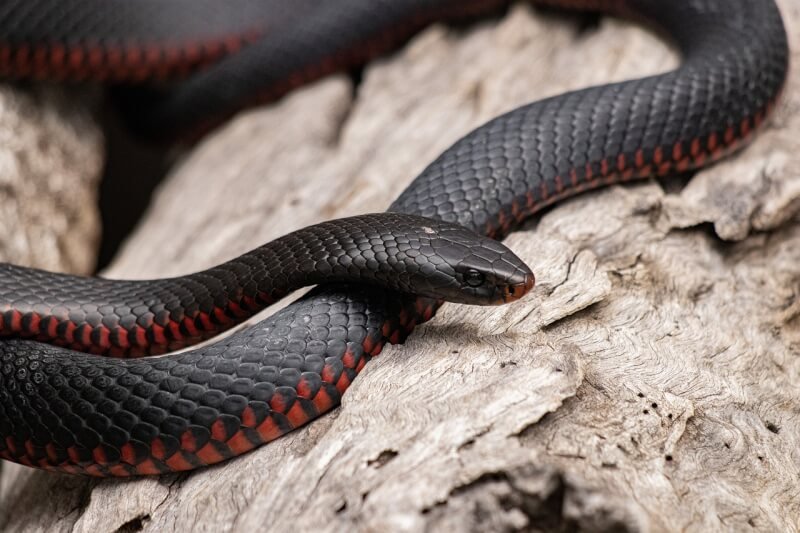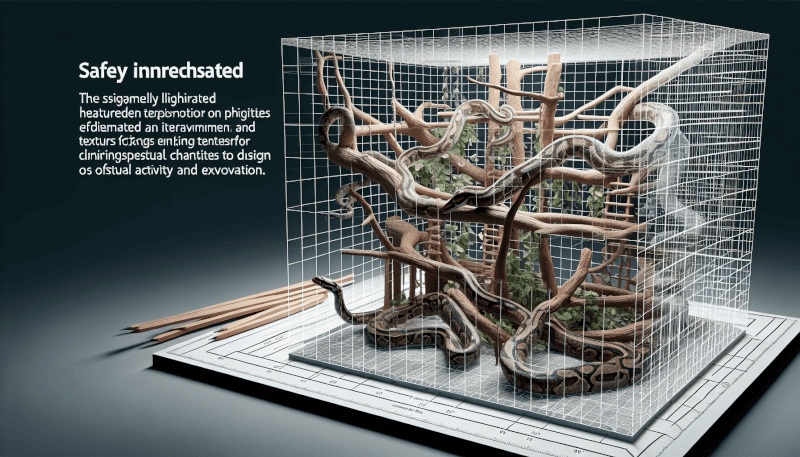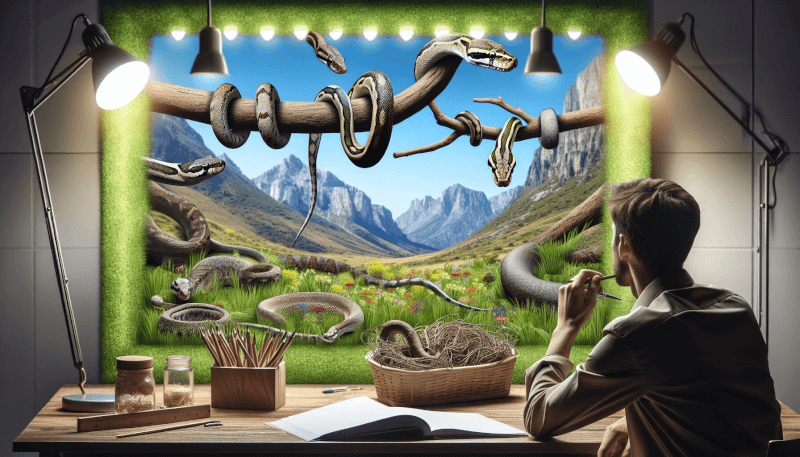Are you a snake owner looking to create a safe and stimulating environment for your slithery friend? Look no further! In this article, we will guide you on how to set up the perfect climbing area for your snake. By incorporating elements that mimic their natural habitat and providing a safe space for them to explore and exercise, you can ensure that your snake is happy and healthy. So, let’s get started on transforming your snake’s space into a paradise of adventure and fun!

Choosing the Right Climbing Equipment
Researching Snake-Specific Climbing Needs
When it comes to creating an ideal climbing area for your snake, it is important to start by researching their specific climbing needs. Different snake species have different abilities and preferences when it comes to climbing. Some snakes are arboreal, meaning they spend a significant amount of time in trees, while others prefer ground-level climbing or burrowing. Understanding the natural behavior and habitat of your snake will help you determine the appropriate climbing equipment to provide.
Selecting Appropriate Climbing Structures
Once you have familiarized yourself with your snake’s climbing needs, it’s time to select the appropriate climbing structures. There are a variety of options available, ranging from branches and artificial vines to purpose-built climbing walls or platforms. It is important to consider the size and weight of your snake when selecting climbing structures, ensuring they can support its weight comfortably and safely. Additionally, choose materials that are easy to clean and maintain.
Ensuring Sturdy and Safe Materials
Safety should always be a priority when creating a climbing area for your snake. Ensure that all climbing structures are made from sturdy and durable materials that can withstand the weight and movements of your snake. Avoid sharp edges or materials that could cause injuries, such as splintering wood. Regularly inspect the climbing structures for any signs of wear or damage, and make necessary repairs or replacements as needed to maintain a safe environment for your snake.
Providing Different Types of Climbing Surfaces
Snakes, like humans, enjoy variety in their climbing environment. Offering different types of climbing surfaces will not only provide stimulation and enrichment but also allow your snake to exercise different muscles and engage in natural behaviors. Consider incorporating both rough and smooth surfaces, as well as horizontal and vertical elements, to create a diverse climbing experience for your snake.
Offering Varied Climbing Heights and Angles
Snakes are skilled climbers and often enjoy climbing at various heights and angles. Providing different climbing heights and angles will allow your snake to explore its environment and mimic their natural behaviors. Incorporating vertical elements, such as climbing walls or tall branches, and horizontal elements, such as platforms or ledges, will provide opportunities for your snake to exercise and explore its surroundings in a safe and engaging way.
Creating a Secure and Snake-Friendly Environment
Setting Up in a Snake-Proofed Area
Before setting up your snake’s climbing area, it is essential to ensure that the surrounding area is snake-proofed. This means taking measures to prevent your snake from escaping or being exposed to potential hazards. Check for any gaps or holes in the enclosure where your snake could escape, and ensure that all doors or openings are secure. Additionally, remove any items or substances that could be harmful to your snake, such as toxic plants or chemicals.
Avoiding Toxic or Harmful Substances
Snakes are very sensitive to their environment, and exposure to toxic or harmful substances can have serious consequences for their health. When setting up their climbing area, be mindful of the materials and substances used. Avoid using toxic plants or chemical treatments in the surrounding area, as these can be harmful if ingested or inhaled by your snake. Opt for natural and non-toxic materials to create a safe and snake-friendly environment.
Ensuring Good Air Quality and Ventilation
Proper air quality and ventilation are crucial for a snake’s overall health and well-being. A well-ventilated environment helps prevent the buildup of harmful gases and ensures proper oxygen flow. When designing your snake’s climbing area, make sure there is adequate airflow to maintain good air quality. Avoid placing the climbing structures in enclosed spaces or areas with poor ventilation, as this can lead to respiratory issues for your snake.
Maintaining Optimal Climbing Temperature
Snakes are ectothermic, meaning they rely on external heat sources to regulate their body temperature. It is essential to provide the appropriate climbing temperature for your snake to ensure their well-being. Research the specific temperature requirements for your snake species and establish a gradient in the climbing area, offering both warm and cooler areas. Use temperature-regulating equipment, such as heat pads or lamps, to maintain the optimal climbing temperature for your snake.
Balancing Lighting and Shade
Proper lighting is important for both the physical and psychological well-being of your snake. Ensure that the climbing area is well-lit with a combination of natural and artificial lighting. Natural light helps regulate the snake’s circadian rhythm, while appropriate artificial lighting can provide additional illumination as needed. Additionally, provide areas of shade to allow your snake to retreat and rest when desired. Balancing lighting and shade will create a comfortable and snake-friendly environment.
Designing Climbing Structures for Snake Comfort
Analyzing Snake Size and Species Requirements
When designing climbing structures for your snake, it is crucial to consider their size and specific species requirements. Some snakes require larger or more secure structures, while others may prefer smaller and more intricate designs. Research the natural climbing behaviors and preferences of your snake species and ensure that the structures provided cater to their needs. Taking these factors into account will ensure that your snake feels secure and comfortable while climbing.
Designing Structures for Naturalistic Climbing Behavior
Snakes exhibit naturalistic climbing behaviors in the wild, and designing structures that mimic these behaviors will provide an enriching climbing experience. Consider the natural environment and habitat of your snake species and replicate elements such as tree branches, vines, or rocks. Incorporating these features into the climbing structures will encourage your snake to exhibit natural climbing behaviors and provide mental and physical stimulation.
Incorporating Hiding Spots and Resting Areas
Snakes require hiding spots and resting areas in their climbing environment to feel secure and comfortable. Incorporate various hiding spots, such as hollow logs or artificial caves, throughout the climbing area. These hiding spots will provide your snake with a sense of safety and security while climbing. Additionally, ensure that there are ample resting areas where your snake can relax and recharge after climbing activities.
Including Natural Materials for Authentic Experience
To create an authentic climbing experience for your snake, consider incorporating natural materials into the climbing structures. Real tree branches, rocks, or artificial foliage can add a sense of realism to the environment and enhance your snake’s climbing experience. Avoid using materials that may be toxic or pose a danger to your snake, and regularly inspect and clean these natural elements to maintain a safe and hygienic climbing area.
Considering Snake Accessibility and Safety
When designing and arranging the climbing structures, it is important to consider snake accessibility and safety. Ensure that the structures are easily accessible and allow your snake to navigate them without difficulty. Avoid placing structures too closely together, as this may impede their movement or lead to accidental falls. Regularly check for any sharp edges or protruding objects that may pose a safety risk to your snake, and make necessary adjustments to guarantee their well-being and security.
Providing Supplemental Heating and Lighting
Researching Snake-Specific Heating Needs
Proper heating is essential for the health and well-being of your snake. Different snake species have different heating requirements, and it is crucial to research and understand the specific heating needs of your snake. Factors such as ambient temperature, humidity, and basking temperature must be considered to provide the optimal heating conditions for your snake in their climbing area.
Choosing Appropriate Heating Elements
When selecting heating elements for your snake’s climbing area, it is important to choose options that are safe, reliable, and suitable for your snake’s specific needs. Common heating options include heat pads, ceramic heat emitters, and heat lamps. Each option has its own benefits and considerations, and it is essential to select the one that best suits your snake’s requirements and the design of the climbing area.
Placing Heat Sources Strategically
Placement of heat sources within the climbing area is crucial to ensure that your snake can access and utilize the heat effectively. Place heat sources in areas where your snake can easily bask and regulate its body temperature. Create temperature gradients within the climbing area, allowing your snake to choose the most suitable temperature zone for its comfort. Regularly monitor the temperature levels and adjust the placement of heat sources as needed to maintain optimal climbing conditions.
Monitoring and Adjusting Temperature Levels
Maintaining the correct temperature levels in the climbing area is essential for your snake’s health and well-being. Regularly monitor the temperatures within the climbing area using thermometers or thermostats. Adjust the heating elements and their placement as necessary to ensure the temperature gradient is maintained. Monitoring and adjusting the temperature levels will help provide your snake with a comfortable and safe climbing environment.
Balancing Lighting Requirements for Climbing and Resting
Lighting plays a crucial role in the overall well-being of your snake. When designing the climbing area, it is important to balance the lighting requirements for climbing and resting. Snakes require a day-night cycle to maintain their circadian rhythm, so ensure there is adequate lighting during the day and darkness during the night. Use full-spectrum lighting to provide the necessary UVB exposure for your snake’s health. Additionally, provide areas of dim lighting or shade to create resting spots for your snake to retreat to when desired.

Creating a Stimulating and Enriching Climbing Environment
Introducing Climbing Challenges and Obstacles
To keep your snake engaged and stimulated in their climbing area, introduce climbing challenges and obstacles. These can include various heights, angles, or even makeshift obstacles for your snake to navigate around. By creating a more challenging environment, you encourage your snake to exercise and explore their climbing skills, promoting mental and physical stimulation.
Utilizing Branches, Vines, and Artificial Foliage
Incorporating branches, vines, and artificial foliage in the climbing area can enhance the authenticity and provide additional climbing opportunities for your snake. Snakes naturally utilize these elements in their natural habitat, and replicating them will stimulate their natural behaviors. Ensure that all branches and vines are sturdy and securely attached to the climbing structures to prevent any accidents or injuries.
Adding Climbing Accessories and Toys
To add an extra layer of enrichment to your snake’s climbing area, consider introducing climbing accessories and toys. These can include rope ladders, PVC tunnels, or snake-safe toys designed specifically for climbing activities. The addition of these accessories provides your snake with new challenges and opportunities for exploration, promoting physical exercise and mental stimulation.
Incorporating Different Textures and Materials
Adding a variety of textures and materials to the climbing area enhances your snake’s sensory experience. Snakes love to explore various textures, such as rough bark or smooth surfaces. Incorporate different materials such as cork, textured mats, or natural substrates to offer a range of sensations for your snake while climbing. Remember to choose materials that are safe and easy to clean.
Enhancing Climbing Space with Environmental Stimuli
Creating a stimulating environment goes beyond the physical structures in the climbing area. Consider adding environmental stimuli such as gentle sounds or visual elements to enhance your snake’s climbing experience. Ambient music or nature soundscapes can provide auditory stimulation, while visual elements such as artificial plants or moving objects can engage your snake’s natural curiosity. Carefully introduce these stimuli to ensure they do not overwhelm or stress your snake, and monitor their reactions for optimal enjoyment.
Balancing Climbing Opportunities with Safety Measures
Ensuring Proper Supervision and Observation
When your snake is utilizing their climbing area, it is important to ensure proper supervision and observation. Regularly monitor your snake’s behavior and climbing activities to ensure they are safe and not experiencing any difficulties or distress. This supervision also allows you to provide immediate assistance if needed and intervene in any potentially dangerous situations.
Preventing Escape and Ensuring Enclosure Security
Even the most skilled climbers can occasionally have accidents or attempt to escape their enclosure. It is crucial to take measures to prevent your snake from escaping and ensure the overall security of the climbing area. Regularly check the enclosure for any gaps or openings that could allow your snake to escape. Secure all doors and openings, and ensure that climbing structures are securely attached to prevent any incidents that may result in an escape or injury.
Regularly Assessing and Maintaining Climbing Structures
Regular maintenance and assessment of the climbing structures are vital for ensuring your snake’s safety. Inspect the structures regularly for any signs of wear, damage, or weakness. Replace any damaged or deteriorated structures promptly to prevent accidents or injuries. Additionally, ensure that all attachments and fastenings are secure, as loose parts can be a safety hazard.
Monitoring Snake Behavior and Adjusting Environment
Snakes may exhibit different behaviors and preferences when it comes to climbing. Monitor your snake’s behavior closely to ensure they are comfortable and enjoying the climbing area. If you notice any signs of stress or discomfort, such as prolonged hiding or avoiding certain structures, consider adjusting the environment to better suit your snake’s preferences. This may involve rearranging structures, introducing new textures, or modifying the temperature gradients within the climbing area.
Observing and Addressing Health and Injury Concerns
While climbing can provide numerous benefits for your snake, it is important to be mindful of any potential health or injury concerns. Regularly observe your snake for any signs of injury or illness, such as wounds, abnormal behavior, or difficulty climbing. Address any concerns promptly by seeking veterinary care for your snake. By staying attentive to your snake’s health and well-being, you can ensure they continue to enjoy their climbing area in a safe and healthy manner.

Creating a Clean and Hygienic Climbing Area
Choosing Easy-to-Clean Climbing Structures
Maintaining a clean and hygienic climbing area is essential for your snake’s health. When selecting climbing structures, choose options that are easy to clean and sanitize. Avoid structures that collect debris or are difficult to access for cleaning purposes. Smooth surfaces and removable components make cleaning more convenient and help prevent the accumulation of dirt, bacteria, or parasites.
Implementing Regular Cleaning and Sanitizing Routine
Establishing a regular cleaning and sanitizing routine is crucial to ensure a clean and hygienic climbing area. Remove any waste, shed skin, or debris promptly to prevent the buildup of bacteria or parasites. Clean and sanitize the climbing structures regularly using snake-safe cleaning products. Follow the instructions on the cleaning products carefully and rinse thoroughly to remove any residue that could be harmful to your snake.
Avoiding Harsh Chemicals and Cleaning Agents
When cleaning the climbing area, it is important to avoid using harsh chemicals or cleaning agents that could be toxic to your snake. Choose snake-safe cleaning products that are specifically formulated for use with reptiles. These products are designed to effectively clean and sanitize the climbing structures without posing a risk to your snake’s health. Always follow the instructions provided by the manufacturer and rinse thoroughly after cleaning.
Cleaning Excretions and Managing Waste
Proper waste management is essential for maintaining a clean and hygienic climbing area. Regularly remove and dispose of any excretions, such as urine or feces, to prevent odor and bacterial growth. Use snake-safe waste disposal methods, such as bagging and sealing waste before disposing of it appropriately. Regular waste management will help create a clean and odor-free climbing environment for your snake.
Preventing Accumulation of Dirt and Debris
Dirt and debris can accumulate in the climbing area over time, creating an unsanitary environment for your snake. Regularly inspect the climbing area for any dirt or debris and remove it promptly. Pay attention to areas that may be harder to reach, such as crevices or corners. Additionally, consider placing protective mats or liners underneath climbing structures to catch any falling debris, making cleaning easier and preventing accumulation.
Fostering Natural Behavior and Encouraging Exercise
Understanding Snake Climbing Behaviors in the Wild
To create an enriching climbing environment, it is important to understand snake climbing behaviors in the wild. Research the natural habitat and climbing behaviors of your snake species to gain insight into their preferred climbing styles and patterns. This understanding will allow you to design the climbing area in a way that closely mimics their natural environment and encourages natural climbing behaviors.
Mimicking Natural Climbing Patterns and Movements
When designing the climbing area, aim to mimic natural climbing patterns and movements. Observe how snakes move and climb in the wild, and incorporate these patterns into the design of the structures. For example, if your snake is arboreal, provide vertical climbing structures such as tall branches or climbing walls. By mimicking natural climbing patterns and movements, you create a more authentic and engaging experience for your snake.
Encouraging Regular Activity and Exercise
Just like any other animal, snakes require regular activity and exercise to maintain their physical health and mental well-being. Providing a stimulating climbing area encourages your snake to engage in regular exercise and stay active. Regular climbing activities help exercise their muscles, promote cardiovascular health, and prevent obesity. Ensure that the climbing area is easily accessible and inviting, so your snake feels encouraged to explore and engage in regular climbing sessions.
Providing Opportunities for Sensory Exploration
Snakes rely heavily on their senses to explore and interact with their environment. When designing the climbing area, consider incorporating opportunities for sensory exploration. Introduce natural elements, textures, or scents to stimulate your snake’s senses. You can also provide hiding spots or resting areas that allow your snake to observe and experience their surroundings. By fostering sensory exploration, you create an enriching and engaging climbing environment for your snake.
Creating Environmental Enrichment Opportunities
Environmental enrichment plays a critical role in promoting the overall well-being of your snake. Enhance the climbing area by introducing additional environmental enrichment opportunities. This can include providing puzzle feeders, scent trails, or even introducing live plants. These enrichment activities keep your snake engaged, mentally stimulated, and provide opportunities for them to exhibit natural behaviors such as foraging or exploring. Monitor your snake’s response to the enrichment activities and adjust as needed to ensure maximum enjoyment.

Training and Stimulating with Positive Reinforcement
Utilizing Positive Reinforcement Training Techniques
Training your snake using positive reinforcement techniques can be a rewarding experience for both you and your pet. Positive reinforcement involves rewarding desired behaviors with treats, praise, or other incentives. When training your snake to use specific climbing structures, use positive reinforcement to encourage and reward their desired behavior. By associating climbing with positive experiences, you motivate your snake and create a trusting and enjoyable training environment.
Training Snakes to Use Specific Climbing Structures
Training your snake to use specific climbing structures can enhance their overall climbing experience and promote the use of the designated areas. Start by gently guiding your snake towards the desired climbing structure and rewarding them with treats or praise when they engage with it. Repeat this process consistently and gradually reduce the guidance until your snake becomes accustomed to using the specific climbing structure on their own. Patience and positive reinforcement are key when training your snake to use specific climbing structures.
Rewarding and Encouraging Desired Climbing Behavior
When your snake exhibits desired climbing behavior, be sure to reward and encourage their efforts. Positive reinforcement can be in the form of treats, verbal praise, or even extra climbing time. By providing positive feedback, you reinforce the behavior and encourage your snake to continue engaging with the climbing structures. Consistency and a positive approach are vital in fostering a strong bond and encouraging desired climbing behavior.
Establishing Consistent Training and Rewarding Schedule
Consistency is key when training your snake and encouraging desired climbing behavior. Establish a consistent training and rewarding schedule to provide structure and predictability. Regular training sessions help reinforce the desired behaviors and establish a routine for your snake. Set aside dedicated time for training and make it an enjoyable experience for both you and your snake.
Ensuring Safety During Training Sessions
Safety is paramount during training sessions with your snake. Always prioritize the safety of your snake and yourself when engaging in training activities. Avoid placing your snake in situations that could potentially lead to stress, discomfort, or injury. If your snake shows signs of agitation or distress, discontinue the training session and make necessary adjustments to ensure their well-being. Respect your snake’s boundaries and adjust your training approach accordingly to ensure safe and positive training experiences.
Optimizing the Climbing Area for Snake Health
Providing Access to Fresh Water at All Times
Proper hydration is crucial for your snake’s overall health and well-being. Ensure that your snake has access to fresh, clean water at all times in their climbing area. Place a shallow water dish within easy reach of the climbing structures and monitor it regularly to ensure it remains clean and filled. Regularly change the water to prevent contamination and provide your snake with a constant source of hydration.
Implementing Proper Nutritional Diet and Feeding Routines
Alongside a suitable climbing area, providing a proper nutritional diet is essential for your snake’s health. Research the specific dietary requirements of your snake species and establish a feeding routine that meets their needs. Offer a variety of prey items to ensure a balanced nutritional intake. Proper nutrition supports your snake’s overall health, growth, and energy levels, contributing to their ability to engage in enjoyable climbing activities.
Monitoring and Controlling Humidity Levels
Humidity plays a vital role in maintaining your snake’s health, particularly for species that require specific humidity levels. Research the specific humidity requirements for your snake species and monitor the humidity levels in the climbing area using a hygrometer. Adjust the humidity as needed using methods such as misting or providing a humidity box. Proper humidity levels contribute to healthy skin shedding, respiratory health, and overall well-being.
Preventing and Managing Parasites and Diseases
Parasites and diseases can pose significant health risks to your snake. Implement preventative measures to minimize the risk of infestations or infections within the climbing area. Regularly check your snake for signs of parasites, such as mites or ticks, and take appropriate action if needed. Practice quarantine protocols when introducing new snakes to prevent the spread of diseases. Additionally, maintain a clean and hygienic climbing area to minimize the risk of bacterial or fungal infections.
Offering Regular Veterinary Check-ups and Care
Regular veterinary check-ups and care are essential for maintaining your snake’s health. Schedule routine veterinary visits for your snake to ensure they receive appropriate vaccinations, examinations, and parasite screenings. Follow your veterinarian’s advice regarding any additional care or treatments required for your snake. Regular veterinary care helps identify and address any health concerns promptly, ensuring your snake’s long-term health and well-being.
In conclusion, creating a safe and enriching climbing area for your snake is essential for their physical and mental well-being. By focusing on choosing the right climbing equipment, designing for snake comfort, and providing supplemental heating and lighting, you can create an environment that encourages exercise and natural behaviors. Balancing climbing opportunities with safety measures, maintaining cleanliness, and ensuring proper nutrition and veterinary care further optimize the climbing area for your snake’s health. With careful consideration and planning, you can create a stimulating and secure climbing environment that promotes your snake’s overall happiness and longevity.



